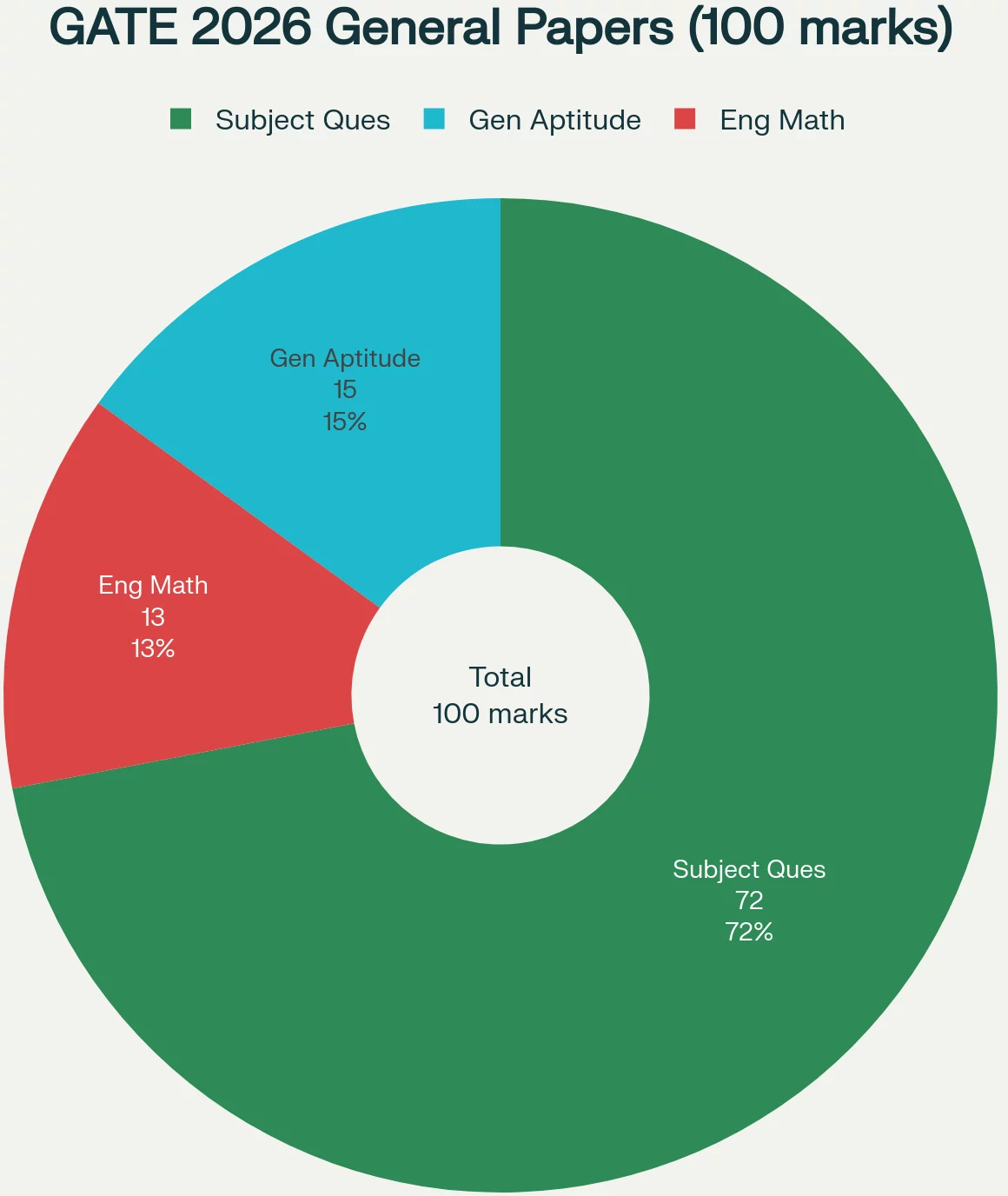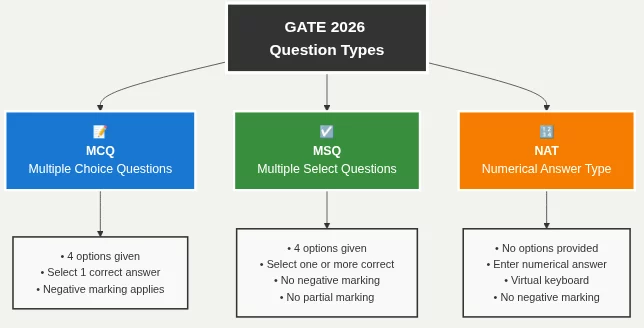GATE Exam Pattern 2026: Check Complete Subject-wise Pattern and Marking Scheme
What’s New in GATE Exam Pattern 2026: The GATE 2026 exam will be conducted by IIT Guwahati on February 7, 8, 14, & 15 for total 30 papers. There will be 2 new subjects – Geomatics Engineering (GE) and Naval Architecture and Marine Engineering (NM), making the total number of subjects 30. Students applying for GATE EXAM 2026 can also opt for two papers from the prescribed combinations.
If you are aiming for the GATE 2026 exam, it is important to familiarize yourself with the GATE exam pattern beforehand. The GATE exam is 3 hours long and consists of 65 questions, divided into general aptitude, engineering mathematics, and the core disciplines. Additionally, all test papers of GATE EXAM 2026 will be entirely objective type. Pattern of questions may include (i) Multiple Choice Questions (MCQ), (ii) Multiple Select Questions (MSQ), and/or (iii) Numerical Answer Type (NAT) questions.
The GATE paper pattern details the exam mode, the types of questions asked, the marking scheme, and the number of questions in each section. Understanding and knowing these details can help you better prepare for your exam and improve your chances of success.

GATE Exam Pattern 2026: Highlights
Here are the details of GATE exam pattern for 2026 including the types of questions, duration, exam mode, and marking scheme:
| Particulars | Details |
|---|---|
| Mode of Examination | Computer Based Test (CBT) |
| Language of examination | English |
| Duration | 3 Hours* |
| Number of papers (Subjects) | 30 test papers |
| Sections | General Aptitude (GA) + Candidate’s Selected Subject(s) |
| Type of Questions | (a) Multiple Choice Question (MCQ) (b) Multiple Select Question (MSQ) (c) Numerical Answer Type (NAT) |
| Testing of abilities | (a) Recall (b) Comprehension (c) Application (d) Analysis & Synthesis |
| Distribution of Marks in all Papers EXCEPT papers AR, CY, DA, EY, GE, GG, MA, PH, ST, XH, and XL | General Aptitude: 15 marks Engineering Mathematics**: 13 marks Subject Questions: 72 marks Total: 100 marks (**XE includes Engineering Mathematics section XE-A of 15 marks) |
| Distribution of Marks in papers AR, CY, DA, EY, GE, GG, MA, PH, ST, XH, and XL | General Aptitude: 15 marks Subject Questions: 85 marks Total: 100 marks |
| Marking Scheme | Questions carry either 1 mark or 2 marks |
| Negative Marking | For a wrong answer chosen in an MCQ, there will be negative marking. For a 1-mark MCQ, 1/3 mark will be deducted for a wrong answer. For a 2-mark MCQ, 2/3 mark will be deducted for a wrong answer. There is no negative marking for wrong answer(s) to MSQ or NAT questions. There is no partial marking in MSQ. |
Read More: GATE Mechanical Engineering Syllabus 2026 | GATE Syllabus For CSE 2026
GATE Exam Pattern 2026: Key Points to Remember
- The total score for the GATE exam is 100.
- All of the questions in the GATE will be related to the GATE test 2026 syllabus.
- According to the GATE question paper pattern 2026, two categories of questions are expected: multiple-choice and numerical answer questions.
- In the case of MCQs, candidates must select one response from four possibilities, whereas in NAT questions, students must input the correct answer using the virtual keyboard.
- Candidates will be given a scribbling pad for rough work.
*In place of Engineering Mathematics, Chemistry will be compulsory for the Life Science (XL) Paper. In XH, Reasoning & comprehension will be a compulsory subject.
Based on the GATE exam pattern for 2025, all papers will contain various question types, including (i) Objective Multiple Choice Questions (MCQ) worth 1 or 2 marks in all sections. Candidates will have four answer choices and must select the correct response. (ii) Numerical Answer Questions worth 1 or 2 marks in all sections. These questions require candidates to enter a real number using the virtual keypad, with no answer choices provided.
Read More: GATE Admit Card
GATE Exam Pattern 2026: Paper Code-Wise Subject Weightage
| Paper Code | GA Marks | Subject Compulsory Section | Optional Subject Marks | Total Marks | Total Time* (Minutes) |
| AE, AG, BM, BT, CE, CH, CS, EC, EE, ES, IN, ME, MN, MT, NM, PE, PI, TF
Subject marks in these papers include questions on Engineering Mathematics (13 marks), which are paper-specific. |
15 | 85 | 100 | 180 | |
| CY, DA, EY, MA, PH, ST | 15 | 85 | 100 | 180 | |
| AR
Part A is Common and Compulsory for all; Part B1 or Part B2 can be selected during the Exam. B1: Architecture or B2: Planning |
15 | 60 | 25 | 100 | 180 |
| GE
Part A is Common and Compulsory for all; Part B1 or B2 can be selected during the Exam. B1 – Surveying and Mapping or B2 -Image Processing and Analysis. |
15 | 55 | 30 | 100 | 180 |
| GG
Part A is Common and Compulsory for all; Part B can either be Geology (B1) or Geophysics (B2) — which must be chosen at the time of Application. |
15 | 25 | 60 | 100 | 180 |
| XE
Section A (Engineering Mathematics) is Common and Compulsory for all; Applicants must select any TWO additional Sections during the Exam. |
15 | 15 | 2 x 35 | 100 | 180 |
| XH
Section B1 (Reasoning and Comprehension) is Common and Compulsory for all; Applicants must select any ONE additional Section at the time of Application. |
15 | 25 | 60 | 100 | 180 |
| XL
Section P (Chemistry) is Common and Compulsory for all; Applicants must select any TWO additional Sections during the Exam. |
15 | 25 | 2 x 30 | 100 | 180 |
GATE Exam Pattern 2026: Types of Questions
Candidates preparing for the GATE exam need to know the types of questions to understand the exam mode and pattern. There will be different types of questions in the GATE 2025 exam, which are mentioned below:
- Multiple Choice Questions (MCQs)
In multiple-choice questions, the student is given four options to choose the correct one. There will be negative markings for every wrong answer.
- Multiple Select Questions (MSQs)
These will be multiple-choice questions, each with four possibilities for applicants to choose one or more. There will be no negative markings in MSQ questions.
- Numerical Answer Type (NAT)
When answering numerical questions, candidates must put their responses in digits. There will be no negative marking on these types of questions.
Read More: GATE Syllabus for Instrumentation Engineering 2025 | GATE Aptitude Syllabus
What Skills Will Be Assessed in the GATE Exam Pattern 2026?
The GATE exam thoroughly evaluates the capabilities of all registered candidates through a diverse range of assessment criteria.
- Recall: The question papers are carefully created to follow the GATE 2025 format, guaranteeing that each candidate’s knowledge is thoroughly examined. The recall portion of the exam asks questions directly about principles, facts, formulas, or laws related to the candidate’s chosen paper.
- Comprehension: There will be questions to assess the candidates’ basic comprehension of their particular fields of study. As a result, applicants must emphasise basic concepts to reach simple conclusions.
- Application: Candidates will need to use their computational and logical reasoning abilities.
- Analysis and Synthesis: The questions include data, diagrams, and images. Candidates can answer them by studying the information provided.
Studying the GATE exam pattern 2026 thoroughly is the right way to begin your prep for GATE 2026. The second step would be to sign up for the IMS GATE Academy Live Online program, where you’ll get not only access to over 750 hours of mentor-led classes but also 24/7 doubt-solving, post-GATE guidance, interview prep, and access to the entire cache of previous years’ GATE papers with video solutions. Just click on the banner above to get in touch with one of our education advisors and take this journey ahead.
Read More: NIT Delhi GATE Cutoff 2025: Check Program-Wise Cutoff | NIT Warangal GATE Cutoff 2025: Check Detailed Program-Wise Cutoffs
FAQs on GATE 2026 Exam Pattern
What is the GATE 2026 exam pattern and duration?
GATE 2026 is a 3‑hour online (CBT) test featuring 65 questions across General Aptitude, Engineering Mathematics, and core engineering subjects.
How many marks are in GATE 2026, and how are they distributed?
The total score is 100 marks, with 10 GA questions (15 marks) and 55 core‑subject questions (85 marks).
What types of questions are there in GATE 2026?
The paper includes MCQs, MSQs, and NAT questions, each worth 1 or 2 marks. The marking and negative marking schemes are included.
Is there a negative marking in the GATE 2026 pattern?
The negative marks are:
- MCQs: –1/3 for 1‑mark wrong, –2/3 for 2‑mark wrong
- No negative markings for MSQs and NATs.
How many sections are in the GATE 2026 paper, and what are they?
The typical structure of sections will have:
- General Aptitude: 15 marks
- Engineering Mathematics: compulsory in many papers
- Core discipline(s): remaining questions
General Aptitude will have 15 marks, Engineering Mathematics will have 13 marks, and Subject Questions will have 72 marks making the total of 100 marks.
Are there sectional time limits in GATE 2026?
There is no sectional time limit—you can manage your 180 minutes across all questions as you prefer.
What is the difference between MCQ, MSQ, and NAT questions in GATE?
The key differences are:
- MCQ: multiple-choice questions with a single correct answer
- MSQ: select all correct options; no negative marking
- NAT: numeric answers entered via on-screen keypad; no options, no negative marking
How many engineering math questions are in GATE 2026?
Typically, Engineering Mathematics carries around 10–13 marks (varies by paper) and is compulsory in almost all technical papers.
Can I appear for two GATE papers in 2026, and how does that affect the pattern?
Yes, you can appear in two papers (e.g., XE + ME) depending on the combinations specified by the authorities. Each paper independently follows the 65‑question, 100‑mark format.
Does the GATE 2026 pattern vary for interdisciplinary papers like XE, XL, and XH?
Yes the patterns are as follows:
- XE: GA + Engineering Maths + any two optional sections
- XL: GA + Chemistry + two life‑science sections
- XH: GA + Reasoning & Comprehension + one humanities section









